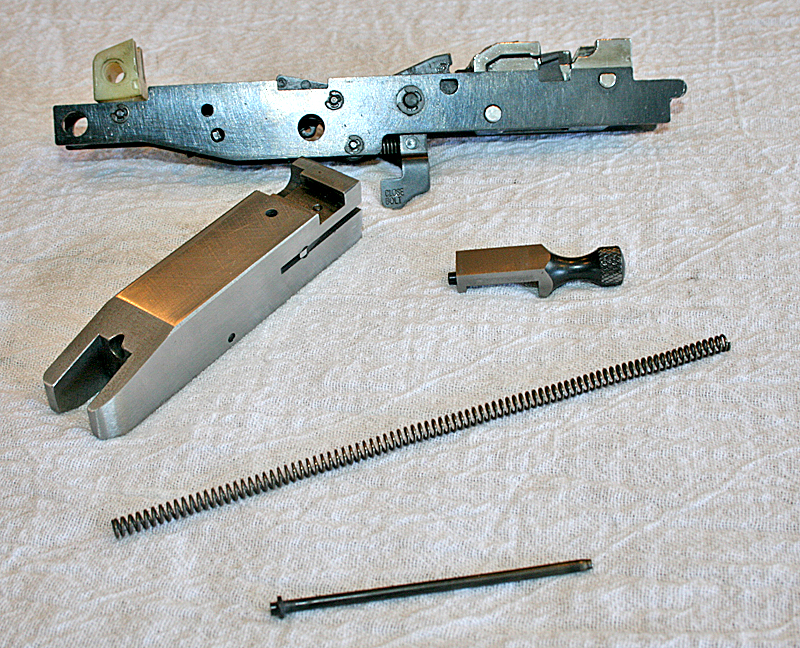
The Lee Load-All is an economical shotshell reloader made for 12,20, and 16 gauge shells. They are sold in a specific gauge (ie 12 gauge), but can be converted to another gauge once you have bought the loader. Lee products have long been a favorite of mine. They build a better mousetrap, dispense with the B.S., and make things affordable. Lee has marketed it as the Load-All II for many years. It's the same loader, it's just that more plastic is used these days.
 |
| Conversion kits change the load-all to another caliber |
The traditional shotshell loaders made by MEC, Texan, etc, are quite pricey and don't include all the bushings you might need. Those bushings aren't cheap if you buy a bunch of them. Lee chose to make most of the Load-All out of plastic, including the bushings. This reduces cost of manufacture, while still being strong enough to make plenty of shells.
I bought my first one around 1999. I used the heck out of it and could not break it. I gave it to my nephew when I took a hiatus from shooting, but bought a used one a few years back. It was missing a few small parts, but Lee services pretty much everything they sell right down to the screws that hold it together. Gotta love Lee.
Some people debate the usefulness of such a tool when you can walk into Wal Mart and buy a box of shells for around $6.50. I shoot plenty of loaded shells. But, I like the ability to doctor up shells of my liking. If I want to load 1 ounce of 6 shot with a light powder charge, I can do it.

It's also important to understand that the price of shotgun shells goes way up once you get away from the promotional loads. You may be able to buy promo loads for cheap, but they are only useful for
shooting clays and upland birds. If you are going after turkeys or any other game where larger shot/heavier loads are necessary, you will pay a lot more than $6.50 for a box of shells. In that case, having the ability to load your own is a real wallet saver.
The small manual that comes with the loader is full of valuable information. Lee dispenses with a lot of the myth and hearsay and really makes loading easy.
I have loaded just about every 12 gauge shell I have ever come across on the range. Some just don't load well. But some load great. Conventional wisdom says that only Winchester AA shells should be reloaded. I used to use AA shells quite a bit, but I found that there were other options. Remington STS shells are another excellent choice. They are very similar to the AA, but have a slightly longer case length and make nicer crimps. Lately I have become a fan of Federal promo hulls for reloading. They make nice crimps and are very plentiful.
It is the crimp that is the tricky part. And, that all boils down to getting a shot load, wad, and shell that like each other. If there is too much shot protruding from the wad, the crimp won't close and you will end up buckling the shell. Too little shot and the crimp just falls in and all your shot falls out. Neither is a good situation. Basically find a combination that works well for you and stick with it.
I have found a trick to help if the crimp falls in. I was adding just a little more shot to the shell before crimping, but that uses expensive shot and adds significant weight to your payload. In other words, if I'm loading 1 ounce shells and end up adding 1/8 ounce of shot to the shell just to make the crimp right, I'm no longer loading 1 ounce shells am I? Adding a light weight filler, such as ground walnut shells right before I load the shot takes up the space but does not add significant weight or use up my costly shot. You could use ground up paper, plastic, or anything you choose. Shell manufacturers often buffer heavy loads anyhow, so it's not like I am advocating anything new.
The Load-All is no match for a MEC or similar loader in terms of quality of feel. But the average shotgunner that just wants the ability to make his own shells really doesn't need more than the Load-All. If you are at all interested in loading shotshells, get one.
 |
| Brass sizer collar can be used to resize the "brass" part of the shell. This slows the process down just a bit. |
 |
| Older units had cast metal bases |
 |
| The primer feed device is optional. I have never had one. |


